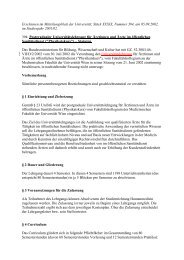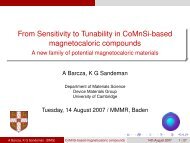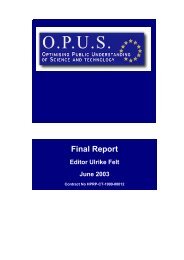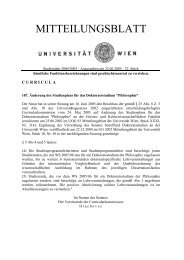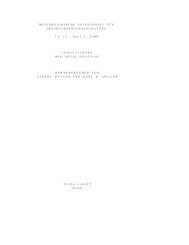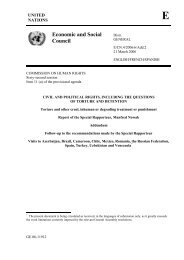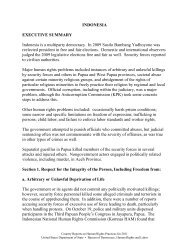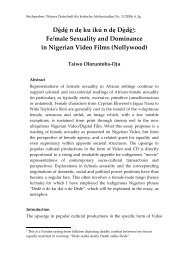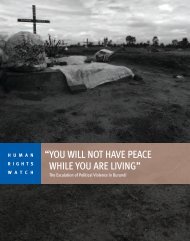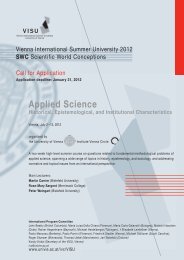(Stand: 25. Juli 2007) ANDERSON, Michael Alan ... - Universität Wien
(Stand: 25. Juli 2007) ANDERSON, Michael Alan ... - Universität Wien
(Stand: 25. Juli 2007) ANDERSON, Michael Alan ... - Universität Wien
Create successful ePaper yourself
Turn your PDF publications into a flip-book with our unique Google optimized e-Paper software.
MEDIEVAL & RENAISSANCE MUSIC CONFERENCE <strong>2007</strong> – WIEN, 7.-11. AUGUST ABSTRACTS<br />
TIETZE, Gwendolyn (CBSO Center, Birmingham)<br />
Gothic Music in 1920s Vienna: inspirations for a language of medieval music<br />
Mittwoch/Wednesday, 8.8., 16.30 Uhr, MuWi, HS 1<br />
Vienna in the 1920s: Arnold Schoenberg and his circle elicited heated controversies, and<br />
Guido Adler and his school worked to embed musicology as an academic subject at the<br />
university and make its work relevant for a wider public. Rudolf Ficker, 1886–1954, was<br />
one of Adler’s students; his particular love was medieval music, which he wrote about,<br />
edited and performed throughout his life. His aim was to bring medieval music to life and<br />
to bring people to understand and love this music that was so different from the classical<br />
and romantic tradition.<br />
In 1927, Adler asked Ficker to put together a programme of Musik der Gotik for the<br />
Beethoven centenary celebrations in Vienna. Adler’s motivation was to satisfy both the<br />
interest by the general public in medieval music, „das schon durch die inneren<br />
Beziehungen zu der Moderne unserer Tage geweckt ist“(Adler), and the scholarly wish to<br />
put into practice theories about how the music worked. The concert, in the Hofburgkapelle,<br />
contained music by, amongst others, Perotin, Vitry, Machaut and Dunstable, and Ficker<br />
was praised for his „divinatorische Kühnheit“ and „künstlerischen Sinn der Interpretation“<br />
(Alfred Einstein).<br />
Ficker was one of the most powerful writers about medieval music of his time.<br />
Working within the paradigms of Geistesgeschichte and Kunstwollen, Ficker used organicist<br />
language, architectural metaphors and borrowed the terms Gothic and Romanesque. He<br />
was greatly inspired by the art historian Wilhelm Worringer and other art historical writers.<br />
His language is full of movement: there is „das Flimmern der rhythmischen<br />
Bewegung“ and „erregte Spannung“ in a motet, or the „nacktes Tongerippe“ of a motet’s<br />
tenor; indeed the thirteenth-century motet becomes „das ebenbürtige Gegenstück zu<br />
unvergleichlichen Erscheinungswelt der gotischen Kathedralen, die aus dem gleichen<br />
geistigen Nährboden emporwuchsen“.<br />
Ficker translated the deep impression the musical notes had made on him into words<br />
to draw in his audience. The drawing of parallels to the better-known world of medieval<br />
art and architecture was just one strategy he employed to make the music familiar. The<br />
language of scholars such as Ficker, concerned with the meanings of medieval music, often<br />
presented the only way into the reality of its sounds. What makes this language of<br />
medieval music even more interesting is that it often moves between the old and the new,<br />
with the discourse about modern music borrowing from that about medieval music, and<br />
vice versa. And for the public this was the only way they would get to know medieval<br />
music in the 1920s, as public concerts were rare and there was not the direct access to the<br />
music one would enjoy later in the century, in the form of popular editions and, above all,<br />
recordings.<br />
� �<br />
- 73 -




